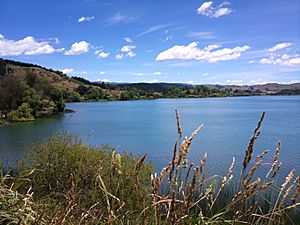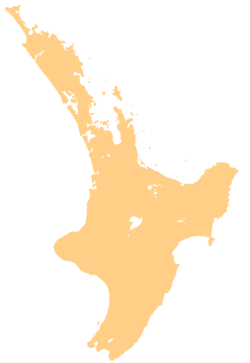Lake Tūtira facts for kids
Quick facts for kids Lake Tūtira |
|
|---|---|

Lake Tūtira in 2009
|
|
| Location | Hawke's Bay, North Island |
| Coordinates | 39°13′19″S 176°53′35″E / 39.222°S 176.893°E |
| Type | mesotrophic |
| Catchment area | 27 km2 (10 sq mi) |
| Basin countries | New Zealand |
| Surface area | 1.74 km2 (0.67 sq mi) |
| Average depth | 20.8 m (68 ft) |
| Max. depth | 42 m (138 ft) |
| Residence time | 2 years |
| Surface elevation | 150 m (490 ft) |
| Islands | 1 |
Lake Tūtira is a beautiful lake located in the north-eastern part of the Hawke's Bay region in New Zealand. It is a popular spot for fishing and enjoying nature.
A long time ago, a man named Herbert Guthrie-Smith explored and farmed a huge area around the lake. He was a naturalist, someone who studies nature. In 1921, he wrote a famous book called Tutira: the story of a New Zealand sheep station. Today, you can find a camp where his old farm used to be.
Close to the lake is a small town called Tutira. It sits right on State Highway 2, about 30 kilometres north of Whirinaki.
Contents
Lake Tūtira: Water Quality and Health
Lake Tūtira's water quality is described as "poor" by Land Air Water Aotearoa. This means the lake often has too many nutrients.
What are Algal Blooms?
The lake sometimes has problems with algal blooms. These happen when tiny water plants called algae grow very fast. They can make the water look green and sometimes smell bad. Algal blooms can also be harmful to fish and other lake creatures.
Lake Tūtira: History and Activities
For hundreds of years, the Māori people lived near Lake Tūtira during different seasons. You can still see the remains of six old Māori fortified villages, called pa sites, around the lake.
Fishing and Walking Trails
If you enjoy fishing, you can catch trout in Lake Tūtira. A stream flows into the northern part of the lake, which is where the trout are found.
There is also a great walking path called the Tutira Walkway. This path goes up to the Table Mountain trig station. From there, you get amazing views over the Hawke's Bay area. The walk takes about five hours to finish.
Lake Tūtira: How it Formed
Lake Tūtira was formed about 6,500 years ago. Scientists study the layers of mud and dirt at the bottom of the lake. These layers tell a story about the lake's past.
Landslides and Lake Sediments
The land around the lake is quite steep. This means that landslides often happen, especially after big storms. These landslides carry dirt and rocks into the lake. Scientists have learned that the size and number of landslides follow a pattern.
A very big storm called Cyclone Bola brought a lot of dirt into the lake recently. This shows how much storms can change the lake over time.


